Star Trek Uses Shields and Deflector Screens Better Than Any Other Sci-Fi Property

Your changes have been saved
Email is sent
Email has already been sent
Please verify your email address.
You’ve reached your account maximum for followed topics.

Ted Lasso Is Looking to Return to Apple TV+ for a Fourth Season After All
This live-action star trek character is quietly crushing it in star trek: prodigy, adam sandler is homer simpson in the simpsons live-action movie concept trailer.
Star Trek has many high-concept ideas across the franchise's near-60-year history. In fact, because of its longevity, many commonplace concepts in science fiction were created or brought into the mainstream by the series. On such idea, starship shields and deflector screens are deployed better in Star Trek than possibly anywhere else in the genre. On the surface, it may seem like they "never work," but the shields used to protect ships work perfectly … the way the storytellers need them to.
In Star Trek: The Original Series , the 1960s-era budget and technological limitations meant producers and directors had to be creative to showcase ship-to-ship space battles. The most iconic way they created visual drama during them was with the "camera shake" technique. The actors would sway in their chairs or throw themselves violently across the set, depending on how well the shields and deflector screens were at blocking alien ships' attacks. As with anything in the episodes, the main goal is to create exciting visual drama for audiences and keep them tuned in. Yet, good science fiction creates, at least, an internal logic for how their significantly advanced technology (thus, indistinguishable from magic) works. But it goes beyond saying that Star Trek 's shields are made using a "graviton" effect or that it's routed through the ship's "deflector dish." Shields and deflector screens have to work in the way the writers need them to while still making rational sense in the world of Star Trek .
RELATED: Matt Jefferies' Final USS Enterprise Design Was Lost When Phase II Fell Apart
How Shields and Deflector Screens Work in the Star Trek Universe
Over the nearly six decades of Star Trek stories, the terms "shields," "deflectors," and "deflector screens" are used almost interchangeably. Shields and "screens" are seemingly the same technology, with the latter term being written off as a language quirk on Kirk's Enterprise . In the 1960s, shields may have conjured an image of armor plating of some kind. A screen better conceptualized the idea of a sci-fi force field that reduced incoming damage to the ship. The deflector, however, was a very well-considered concept. Even in the mid-1960s, series creator Gene Roddenberry understood a ship flying through space at a high rate of speed would encounter "space dust" that would pierce through the hull like a microscopic bullet. So, the deflector dish sends out a pulse that pushes dust, debris, or other smaller things out of the ship's way as it travels. It's since evolved to be used as a shield during combat and even a weapon in its own right.
Yet, keen Star Trek fans likely notice that even when "shields are at 80 percent," the ship still seems to take damage. Sparks and crewmembers fly from the impact, and if the budget allows, hull damage can be seen on the ship. This is because the shields, whether on their own or amplified by the deflector dish, don't negate damage. In some cases, they do (whenever the attacking aliens don't need to be a threat within the story). Yet, usually, the energy field that surrounds the ship in a bubble simply reduces damage. Think of it like a video game with a "block" feature that still causes the health bar to drop. It's not as much if the player didn't block, but it doesn't protect them from all damage. This is why when shields are up, Star Trek ships are still battered by enemy weapons, mysterious forces, or energy fields in space.
The shields work on a percentage countdown where a higher number is better. Even with shields at maximum (during a climactic battle, at least), Star Trek ships feel the brunt of phaser blasts and photon torpedoes. Adding the deflector dish allows some of that damage to be reflected into space. Still, even as the shields fall (dramatically) to 50 percent, 20 percent, and so on, they still protect the ship better than they would without them. As evidenced by a number of the series, without any shields, one or two photon torpedoes could ultimately destroy a starship down to the atoms.
RELATED: Star Trek Is Primed for a Return of These Previously-Hated Aliens
How Star Trek Storytellers Use Deflector Shields and Screens
While some of the more sci-fi purists in the audience may feel this is a cop-out, deflector screens, and shields work only as well as the Star Trek storytellers need them to . There are countless episodes where the shields are working fine one second and, in the next, the ship has lost all power to them or the deflector. The driving force behind these decisions isn't a lack of care about "canon" or anything like that. They are, instead, used to create the most interesting and dramatic circumstance in the story. Sometimes, the captain will push on, even though shields are dangerously low. This is either to create a heroic moment or, in rare cases, allow another character to chastise them for risking the ship for the wrong reasons.
In its second and third waves, Star Trek has employed experts in both science and the franchise canon in an effort to keep things consistent across the series and eras. Yet, these things serve the stories being told, not vice versa. Deep Space Nine 's USS Defiant had "ablative armor," while the NX-01 from Enterprise had "polarized hull plating." These things are technically different than shields and deflector screens. However, they work functionally the same way. How well the work and how much damage the ship sustains depends not on the technical specs of the shields, but the needs of an individual series or story. While the storytellers endeavor to bring consistency to the universe, everything works better when the specific episode or film takes precedence over the "rules" of the technology.
Some level of suspension of disbelief is required of Star Trek viewers, especially where pretend technology like energy shields or deflector screens are concerned. Despite the needs of different stories and eras, these damage reduction elements are applied with relative consistency. Yet, suppose one battle is particularly harrowing or, conversely, far too easy for the crew. In that case, audiences should look for the reason the story requires that rather than taking to social media to lambast the storytellers for getting it "wrong."

- Search forums
Follow along with the video below to see how to install our site as a web app on your home screen.
Note: This feature may not be available in some browsers.
- Star Trek Series | 2364 - 2378
- Star Trek: Voyager
Voyager beaming through shields
- Thread starter LimonaM
- Start date Mar 17, 2008
Lieutenant Junior Grade
- Mar 17, 2008
Hello. I like Voyager, but how can they beam through shields? Did i miss something? And they do that in a MANY episodes. That really bothers me. Did they say somewhere, that they can beam through? Any explanation? Thanks.
Additional Pylon
Which episodes are you referring to? I think they did that occasionally as the plot warranted it, but not on a regular basis. And they can't beam through shields, because that's a general Trek rule.
Fleet Admiral
To be sure, "no beaming through shields" was first established in the TOS episode "A Taste of Armageddon" - and then blatantly broken in that very same episode! In the 24th century, a couple of techniques have been demonstrated for beaming through shields. Our VOY heroes could be using these techniques when we aren't looking. But the easier explanation is that they in fact drop shields for every transport, and we simply don't notice it because the camera is looking elsewhere when Janeway gives the command to drop shields. What specific examples would there be of VOY violations of the rule? There's some murkiness in e.g. "Dragon's Teeth", but nothing that can't be covered with the "they dropped 'em when we looked elsewhere" explanation... Timo Saloniemi
The one occasion that really stands out to me is Rise , but beaming through the shields was the *least* of the problems with that particular episode. ETA: Actually, Timo , the "no beaming through the shields" rule was first established in Arena .
Vice Admiral
Didn't they establish some treknobabble explanation for how it's possible, based on shield modulation frequencies, or something? If you know the shield frequency you can get through? That's how the Duras sisters fired through the shields to bring down the Enterprise-D, isn't it?
Mark_Nguyen
Rear admiral.
I believe it was mentioned in the Voyager S1 writer's bible that beaming through shields was not a big deal anymore, thanks to such epsiodes as TNG "Wounded". In that one, O'Brien found a way to beam through the raised shields of the USS Phoenix via her known "frequency windows". It's routine enough these days that they don't even mention it in dialogue during the pilot episode "Caretaker", where multiple people beam to and from Voyager even when she's in the middle of a pitched battle. DS9 was an apparent exception to this rule though, as Defiant had her cloak and I can't think of any of the few battles of the station itself that involved the station beaming stuff off or back. Mark
- Mar 18, 2008
...The big deal would be that the enemy cannot beam through your shields. And that held true rather well in all the shows, except when it was a plot point that shields couldn't stop the weally weally strong enemy of the week. It might well be that only the most advanced ships in the DS9/VOY era can beam through their own shields, and the ships at Sisko's disposal didn't fit that category. Timo Saloniemi
- Mar 21, 2008
I think B'Ellana came up with something called a "skeletal lock" in the episode where Chakotay was kidnapped by Seska and the Kazon. That may have been to get through a dampening field though...
- Mar 23, 2008
I think you're being trolled.
The Borg Queen
Have the transporter matter stream at the same frequency modulation as the shields. It's like having two polarising filters aligned correctly.
Director of Comedy
- Mar 24, 2008
Mark_Nguyen said: It's routine enough these days that they don't even mention it in dialogue during the pilot episode "Caretaker", where multiple people beam to and from Voyager even when she's in the middle of a pitched battle. Click to expand...
kimc said: I think B'Ellana came up with something called a "skeletal lock" in the episode where Chakotay was kidnapped by Seska and the Kazon. That may have been to get through a dampening field though... Click to expand...
alpinedigital
- Jul 21, 2015
LimonaM said: Hello. I like Voyager, but how can they beam through shields? Did i miss something? And they do that in a MANY episodes. That really bothers me. Did they say somewhere, that they can beam through? Any explanation? Thanks. Click to expand...
Flet Adirmal
- Jul 22, 2015
Tachyons.
Similar threads
- May 7, 2024
- Star Trek: Deep Space Nine
- Jul 28, 2024
- Star Trek: Strange New Worlds
- Jun 1, 2024
- Aug 11, 2024
- Arvis Taljik
- Jun 22, 2024
Sign up / Register
- General Trek Discussion
- Star Trek: Enterprise
- Star Trek - The Original & Animated Series
- Star Trek: The Next Generation
- Star Trek: Discovery
- Star Trek: Picard
- Star Trek: Lower Decks
- Star Trek: Prodigy
- Star Trek Movies I-X
- Star Trek Movies: Kelvin Universe
- Future of Trek
- Trek Gaming
- Trek Literature
- Fan Fiction
- Fan Productions
- CSI (at Talk CSI)
- Science and Technology
- Sports and Fitness
- Web Sites/Design
- Miscellaneous
- Site Forums
YOU ARE ACCESSING THE LCARS COMMAND INTERFACE - VOYAGER SCREENS DATABANK
'Click on pictures to view animations'.

Deflector Shields: The Best Offense Is a Good Defense
- First Online: 25 August 2016
Cite this chapter

- Mark E. Lasbury 2
750 Accesses
Deflector shields in Star Trek are mainly directed toward absorbing fire from hostile ships or deflecting large objects from the path of the ship. However, there are also navigational deflector shields that protect the ship from small objects that might be encountered while the ship is under power. This is more similar to the shields currently being developed by the engineers and scientists of the various space programs. It is cosmic radiation that poses the greatest to the astronauts that will be traveling to Mars in the near future. Secondary to this is the threat posed by small micrometeroids that could do damage to the hull. Traditional shielding is adequate for the solid objects, but some measure of deflecting shield will be necessary to move charged particles and electromagnetic waves from harming the human on board. Using the Earth as a model, several laboratories are developing superconducting magnetic shields to deflect charged nuclei and EM waves in the cosmic radiation. Plasma shields also help deflect charged particles, and even better, models of Moon mini-magnetospheres show that magnetic shields will build plasma shields over time, confining the plasma within the magnetic field lines.
Lasers!? Lasers can’t even penetrate our navigation shields. Don’t they know that? —Captain Jean Luc Picard TNG: The Outrageous Okona
This is a preview of subscription content, log in via an institution to check access.
Access this chapter
Subscribe and save.
- Get 10 units per month
- Download Article/Chapter or eBook
- 1 Unit = 1 Article or 1 Chapter
- Cancel anytime
- Available as PDF
- Read on any device
- Instant download
- Own it forever
- Available as EPUB and PDF
- Compact, lightweight edition
- Dispatched in 3 to 5 business days
- Free shipping worldwide - see info
Tax calculation will be finalised at checkout
Purchases are for personal use only
Institutional subscriptions
MM Acharya, LA Christie, ML Lan, E Giedzinski, JR Fike, S Rosi, CL Limoli. Human neural stem cell transplantation ameliorates radiation-induced cognitive dysfunction. Cancer Research . 71(14); 4834–4845, 2011. doi: 10.1158/0008-5472.CAN-11-0027 . http://cancerres.aacrjournals.org/content/71/14/4834.long
R Bamford, KJ Gibson, AJ Thornton, J Bradford, R Bingham, L Gargate, LO Silva, RA Fonseca, M Hapgood, C Norberg, T Todd, and R Stamper. The interaction of a flowing plasma with a dipole magnetic field: measurements and modelling of a diamagnetic cavity relevant to spacecraft protection. Plasma Physics and Controlled Fusion , 50 124025 (11 pp) November 4, 2008. Online. DOI: 10.1088/0741-3335/50/12/124025 . http://iopscience.iop.org/article/10.1088/0741-3335/50/12/124025/meta
R Bamford, B Kellett, J Bradford, TN Todd, R Stafford-Allen, EP Alves, L Silva, C Collingwood, IA Crawford, and R Bingham. An exploration of the effectiveness of artificial mini-magnetospheres as a potential solar storm shelter for long term human space missions. Acta Astronautica 105(2); 385–394, 2014. doi: 10.1016/j.actaastro.2014.10.012 . http://www.sciencedirect.com/science/article/pii/S0094576514003798
DI Blokhintsev and FM Gal’perin. Gipoteza neitrino i zakon sokhraneniya energii (Neutrino hypothesis and conservation of energy). Pod Znamenem Marxisma ( Under the Banner of Marxism ) 6; 147–157, 1934.
Google Scholar
R Bruce, and B Baudouy. Cryogenic design of a large superconducting magnet for astroparticle shielding on deep space travel missions. Physics Procedia 67; 264-269, 2015. doi: 10.1016/j.phpro.2015.06.085 . http://www.sr2s.eu/images/documents/Bruce2015.pdf
F Cain. Are gamma ray bursts dangerous? UniverseToday.com Guide to Space. January 12, 2015. Accessed September 30, 2015. http://www.universetoday.com/118140/are-gamma-ray-bursts-dangerous/
Q Cheng, TJ Cui, WX Jiang, and BG Cai. An omnidirectional electromagnetic absorber made of metamaterials. New Journal of Physics 12; 063006, 2010. doi: 10.1088/1367-26301/12/6/063006 . http://iopscience.iop.org/article/10.1088/1367-2630/12/6/063006
MN Cherndub. Spontaneous electromagnetic superconductivity of vacuum in a strong magnetic field: evidence from the Nambu-Jona-Lasinio model. Physics Review Letters . 10; 142003, 2011. doi: 10.1103/PhysRevLett.106.142003 . http://journals.aps.org/prl/abstract/10.1103/PhysRevLett.106.142003
JD Cherry, B Liu, JL Frost, CA Lemere, JP Williams, JA Olschowka, and MK O’Banion. Galactic cosmic radiation leads to cognitive impairment and increased Aβ plaque accumulation in a mouse model of Alzheimer’s disease. PLoS ONE 7(12); e53275, 2012. doi: 10.1371/journal.pone.0053275 . http://journals.plos.org/plosone/article?id=10.1371/journal.pone.0053275
LT Chylack, LE Peterson, AH Feiveson, ML Wear, FK Manuel, WH Tung, DS Hardy, LJ Marak, and FA Cucinotta. NASA study of cataract in astronauts (NASCA). Report 1: cross-sectional study of the relationship of exposure to space radiation and risk of lens opacity. Radiation Research 172(1); 10-20, 2009. doi: 10.1667/RR1580.1 . http://www.bioone.org/doi/10.1667/RR1580.1?url_ver=Z39.88-2003&rfr_id=ori%3Arid%3Acrossref.org&rfr_dat=cr_pub%3Dpubmed &
FA Cucinotta, M Alp, FM Sulzman, and M Wang. Space Radiation risks to the central nervous system. Life Sciences in Space Research 2; 54-69, 2014. doi: 10.1016/j.lssr.2014.06.003 . http://www.sciencedirect.com/science/article/pii/S2214552414000339
A Del Rosso. A superconducting shield for astronauts. CERN website. August 5, 2015. Accessed January 27, 2016. http://home.cern/about/updates/2015/08/superconducting-shield-astronauts
WT Deng and XG Huang. Event-by-event generation of electromagnetic fields in heavy ion collisions. Physical Review C 85; 044907, 2012. doi: 10.1103/PhysRevC.85.044907 . http://journals.aps.org/prc/abstract/10.1103/PhysRevC.85.044907
B Dodson. Rheinmetall tests new active defense system under live fire. Gizmag January, 31, 2012. Accessed November 4, 2015. http://www.gizmag.com/rheinmetall-ads-live-fire-test/21278/
F Dyson. Is a graviton detectable? Poincare Prize Lecture. International Congress of Mathematical Physics. Aalborg, Denmark. August 6, 2012. http://publications.ias.edu/sites/default/files/poincare2012.pdf
J Emspak. Sci-fi cloaking device could protect soldiers from shock waves. Live Science . March 24, 2015. Accessed January, 26, 2016. http://www.livescience.com/50236-boeing-device-could-block-shock-waves.html
BE Gavett. Mild traumatic brain injury: a risk factor for neurodegeneration. Alzheimer’s Research & Therapy 2; 18, 2010. doi: 10.1186/alzrt42 . http://alzres.biomedcentral.com/articles/10.1186/alzrt42
D Goure. Now is the time to provide US armored vehicles with active protection systems. Lexington Institute . August 3, 2015. Accessed January 35, 2016. http://lexingtoninstitute.org/now-is-the-time-to-provide-u-s-armored-vehicles-with-active-protection-systems/
B Grzeskiewicz, A Sierakoqaski, J Marczewski, N Palka, and E Wolarz. Polarization-insensitive metamaterial absorber of selective response in terahertz frequency range. Journal of Optics 16(10); 105104, 2014. doi: 10.1088/2040-8978/16/10/105104 . http://iopscience.iop.org/2040-8986/16/10/105104
D Hambling. The Pentagon’s wall-of-light laser shield. Popular Mechanics Online . January, 22, 2013. Accessed May 15, 2015. http://www.popularmechanics.com/military/research/a8626/the-pentagons-wall-of-light-laser-shield-15008409/
K Hill. Did Boeing just patent a deflector shield? Nerdist March 24, 2015. Accessed on December 10, 2015. http://nerdist.com/did-boeing-just-patent-a-deflector-shield/
S Johnson. Star Trek: Mr. Scott’s Guide to the Enterprise . Pocket Book, NY, NY. 1987. ISBN13: 9780671635763
S LaGrone. Navy develops torpedo killing torpedo. USNI News . June 20, 2013. Accessed January 20, 2016. http://news.usni.org/2013/06/20/navy-develops-torpedo-killing-torpedo
The LIGO Scientific Collaboration. J Aasi, BP Abbott, T Abbott, et al. Advanced LIGO. Classical and Quantum Gravity 32(7); 074001, 2015. doi: 10.1088/0264-9381/32/7/074001 . http://www.iopscience.iop.org/article/10/1088/0264-9381/32/7/074001/meta
J McGuire, A Toohie, and A Pohl. Shields up! The Physics of Star Wars. Journal of Physics Special Topics 12(1): P6_11, 2013. https://physics.le.ac.uk/journals/index.php/pst/article/view/678/486
BM Rabin, JA Joseph, B Shukitt-Hale, and KL Carrihill-Knoll. Interaction between age of irradiation and age of testing in the disruption of operant performance using a ground-based model for exposure to cosmic rays. Age (Dordrecht) 34(1); 121–131, 2012. doi: 10.1007/s11357-011-9226-4 . http://link.springer.com/article/10.1007/s11357-011-9226-4
N Shachtman. Genius computer stops rockets right before impact. Io9, we come from the future . June 25, 2011. Accessed January 25, 2016. http://io9.gizmodo.com/5815529/genius-computer-stops-rockets-right-before-impact
I Smolyaninov. Quantum electromagnetic “black holes” in a strong magnetic field. Journal of Physics G: Nuclear and Particle Physics . 40; 015005, 2013. doi: 10.1088/0954-3899/40/1/015005 . https://www.researchgate.net/publication/258294051_Quantum_electromagnetic_’black_holes’_in_a_strong_magnetic_field
I Smolyaninov. Critical opalescence in hyperbolic metamaterials. Journal of Optics 13; 125101, 2011. doi: 10.1088/2040/8978/13/12/125101 . http://iopscience.iop.org/article/10.1088/2040-8978/13/12/125101
Technology Quarterly, Q2. The armour strikes back. The Economist . June 4, 2011. Accessed on October 2, 2015. http://www.economist.com/node/18750636
BM Walsh, JC Foster, PJ Erickson, and DG Sibeck. Simultaneous ground- and space-based observations of the plasmaspheric plume and reconnection. Science 343(6175); 1122-1125, 2014. doi: 10.1126/science.1247212 . http://www.sciencemag.org/content/343/6175/1122.long
SC Westover, RB Meinke, R Battiston, WJ Burger, S Van Sciver, S Washburn, SR Blattnig, K Bollweg, RC Singleterry, and DS Winter. Magnet Architectures and Active Radiation Shielding Study (MAARS). Final Report for NASA Innovative Advanced Concepts Phase I . May, 2014. http://ston.jsc.nasa.gov/collections/TRS
R Whitwam. Boeing patents sci-fi force field that deflects explosive shockwaves. ExtremeTech website March, 23, 2015. Accessed June 16, 2015. http://www.extremetech.com/extreme/201777-boeing-patents-sci-fi-force-field-that-deflects-explosive-shock-waves
M Wieser, S Barabash, Y Futaana, M Holmstrom, A Bhardwaj, R Sridharan, MB Dhanya, A Schaufelberger, P Wurz, and K Asamura. First observation of a mini-magnetosphere above a lunar magnetic anomaly using energetic neutral atoms. Geophysical Research Letters 37; L05103, 2010. doi: 10.1029/2009GLO041721 . http://onlinelibrary.wiley.com/store/10.1029/2009GL041721/asset/grl26727.pdf?v=1&t=ijnn3m5c&s=6dcb5451a6da7d69bc754592911c1a2012df2d66
Download references
Author information
Authors and affiliations.
Indianapolis, IN, USA
Mark E. Lasbury
You can also search for this author in PubMed Google Scholar
Corresponding author
Correspondence to Mark E. Lasbury .
Rights and permissions
Reprints and permissions
Copyright information
© 2017 Springer International Publishing Switzerland
About this chapter
Lasbury, M.E. (2017). Deflector Shields: The Best Offense Is a Good Defense. In: The Realization of Star Trek Technologies. Springer, Cham. https://doi.org/10.1007/978-3-319-40914-6_4
Download citation
DOI : https://doi.org/10.1007/978-3-319-40914-6_4
Published : 25 August 2016
Publisher Name : Springer, Cham
Print ISBN : 978-3-319-40912-2
Online ISBN : 978-3-319-40914-6
eBook Packages : History History (R0)
Share this chapter
Anyone you share the following link with will be able to read this content:
Sorry, a shareable link is not currently available for this article.
Provided by the Springer Nature SharedIt content-sharing initiative
- Publish with us
Policies and ethics
- Find a journal
- Track your research
- More to Explore
- Series & Movies
Episode Preview: Resolutions
Season 2, Episode 25
When Captain Janeway and Chakotay contract an incurable virus they are left on a planet which shields them from its effects. While Janeway searches for a cure, she begins to form a deeper relationship with her first officer.
Stay tuned to StarTrek.com for more details! And be sure to follow @StarTrek on Facebook , Twitter , and Instagram .

Year of Hell
In numerous alternate timelines , " The Year of Hell " was the name that was given to the events taking place in 2374 by the crew of the USS Voyager , specifically a series of conflicts with the Krenim Imperium . In both timelines, the temporal weaponry of the Imperium inflicted critical damage on the starship .
First iteration [ ]
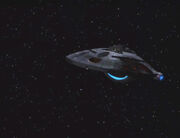
Voyager scarred by the Year of Hell
In this timeline, first contact with the Krenim took place on stardate 50973, when a single vessel launched an attack on the starship. Voyager 's weapons fire was ineffective against the attacking vessel, and chroniton torpedoes were able to penetrate the hull. Hull breaches were recorded on Deck 7 , and the engineering station on the bridge exploded, killing Captain Kathryn Janeway and Chief Engineer B'Elanna Torres . Nine other casualties were recorded, with power down on Decks 4-12, The Doctor going off-line as a result (he remained out of action for the remainder of the year). The mess hall was turned into a makeshift medical facility. Neelix was forced to wear an operations division uniform, eventually becoming a full-fledged security officer .
One torpedo failed to detonate during the battle, and became lodged in Voyager 's hull on Deck 11, section 2. Fragments of the torpedo leaked chroniton radiation into the ship, irradiating a large portion of the crew. As a result, the entire crew was inoculated , but residual chronitons remained dormant in those affected.
Following the initial battle, a protracted conflict took place, inflicting severe damage on Voyager . Chakotay took command of the ship, ultimately managing to escape Krenim space. During the year, Kes and Tom Paris became romantically involved, producing a daughter named Linnis , who later gave birth to Andrew Kim . At the time of her birth, the main computer core had been off-line for several weeks, life support was restricted to three out of fourteen decks, and non-essential power had been rerouted to tactical systems. When The Doctor was brought back on-line, he was given hair and also chose the name " Dr. Van Gogh ".
The timeline in which these events occurred was presumed to be negated when Kes' chroniton contamination was triggered by The Doctor's attempts to save her life with a bio-temporal chamber in 2379 , resulting in her traveling backwards along her personal timeline to a point in late- 2373 , prior to the encounter with the Krenim. She later documented her knowledge of the Krenim in a report. ( VOY : " Before and After ")
According to the events of " The Gift ", Kes pushed Voyager 9,500 light years through Borg space before they reached Krenim space. It is not explained in "Before and After" how the ship crossed this space without Kes' transformation. In the non- canon Myriad Universes novel Infinity's Prism , it is alleged that this timeline's Voyager crew completed their deal with the Borg and stole a transwarp coil in a Borg wreck, providing a solution to the problem.
Second iteration [ ]
In this timeline, first contact with the Krenim was significantly delayed, as Voyager first encountered the Nyrians and the Borg . ( VOY : " Displaced ", " Scorpion ") These events resulted in the departure of Kes and the placing of Seven of Nine aboard the starship. ( VOY : " The Gift ") This timeline continued to evolve very differently, culminating in the destruction of Voyager and death of Janeway. ( VOY : " Year of Hell ", " Year of Hell, Part II ")
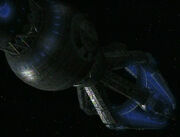
The Krenim temporal weapon ship
Two hundred years prior, Annorax , a Krenim scientist , had developed a temporal weapon ship capable of altering history. Using it to eliminate their greatest rivals, the Rilnar , Annorax failed to fully understand the complexities of the alteration, and a deadly virus devastated the Imperium. Trying again, Annorax was able to restore 98% of the Imperium, with the exception of Kyana Prime , home of his wife, who was erased from existence as a result. Annorax and his crew spent the next two centuries attempting to correct that mistake. In March 2374, the Krenim's sector of space was dominated by the Zahl , who, in that timeline, had defeated the Imperium a number of years earlier.
In December 2373, when attempting to evade a rogue comet , Voyager altered course to a heading that took the ship into Krenim space. In this timeline, first contact with the Krenim took place on 17 March (Day 1), when a single vessel launched an attack against the starship. Due to temporal interference from Annorax, the Krenim Imperium was non-existent and there was no significant damage. A few days later, during Voyager 's meeting with a Zahl representative, Annorax altered time again to restore the Imperium and erase the Zahl. Voyager was significantly more damaged and on red alert, with shields failing. The second Year of Hell began, and Voyager itself was identified as Component 0-4-9- Beta , which was originally classified as an inert component.
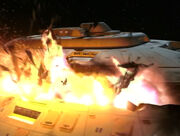
Deck 5's conduits overload
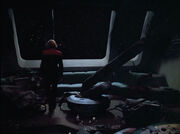
The damaged ready room aboard Voyager
On 17 April (Day 32), a Krenim attack resulted in the overload of EPS conduits across the starboard side of Deck 5, sections 10-53, killing two crew members. Voyager happened to take down the aft shields of the Krenim warship during the battle and destroyed it by releasing photon torpedoes like mines, but apparently another ship took its place. Attempts to modify Voyager 's shields to protect against the temporal flux of the chroniton torpedoes had proven unsuccessful, phaser banks were burned out, and torpedo launchers were off-line. 2 May (Day 47) saw nineteen main power relays severed, shutting down the turbolift network. Later, Seven of Nine discovered one chroniton torpedo that had failed to detonate in battle, and was able to carry out a more direct analysis of it to work on providing Voyager with a suitable defense. The torpedo later detonated, blinding Lt. Commander Tuvok permanently as he attempted to get Seven to safety. At the same time, Tom Paris came up with an idea to use transverse bulkheads in order to minimize damage.
By 20 May (Day 65), the power grid on Deck 11 had been completely destroyed, rendering the replicator system nearly inoperative, limited to emergency rations only. Seven decks had lost life support, forcing the surviving crew into close quarters. It was at this point that the temporal shielding came online, limiting further damage. This temporal field Voyager generated was enough to throw off Annorax's calculations . At this time, Neelix was forced to wear an operations division uniform, eventually becoming a full-fledged security officer .
As Annorax attempted another temporal incursion at the Garenor homeworld, Voyager 's new shields interfered with the event, reducing the Imperium to a pre-warp civilization. This brought the Federation starship in direct contact with the weapon ship, as Annorax sought to eliminate Voyager from history. Although Annorax captured Chakotay and Paris as 'samples' from Voyager , the ship's temporal shielding protected it long enough to engage warp 7 and escape - the temporal weapon ship being only capable of warp 6 at best - but the resulting warp stresses caused serious damage to the outer hull before Voyager returned to impulse.
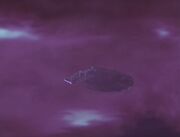
Voyager hides in a class 9 nebula
With life support failing and the ship no longer able to sustain its crew, Janeway ordered the evacuation of Voyager on 28 May (Day 73); the senior staff remained on board, and subsequently took refuge in a class 9 nebula . By 27 July (Day 133), only one warp nacelle was functional, and the ventilation system was failing, allowing nebular gas to penetrate the ship. The remaining crew (Janeway, Kim, Seven, Torres, Tuvok and Neelix) drank "the elixir of endurance " and kept on going.
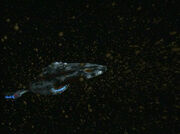
Voyager impacts a micrometeoroid shower
On 12 September (Day 180), a micrometeoroid storm in open space almost caused the loss of one of the nacelle pylons, save for the last-second reinitializing of the navigational deflector , which brought the ship's inoperable shields online after Captain Janeway's emergency manual repairs fixed the deflector and the shields. Reactivating the deflector left Captain Janeway with severe burns .
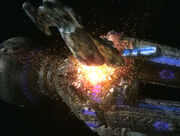
Voyager rams the Krenim weapon ship
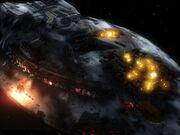
Voyager heavily damaged
Seeking allies to eliminate the weapon ship, Voyager was able to forge a coalition with the Nihydron and the Mawasi ; a task force, led by Voyager , was dispatched to track down and destroy the vessel, finally locating it on 28 October (Day 226), thanks to a coded message from Paris. Voyager 's crew was divided up among the taskforce, with Janeway remaining on Voyager to coordinate the attack. Engaging the ship on 28 November (Day 257), Voyager suffered the loss of several sections of the dorsal saucer, including the forward bulkhead of the bridge, when Annorax opened fire with conventional weapons, causing a Nihydron vessel to collide with the Starfleet ship. The weapon ship's temporal core was deactivated by Obrist , Annorax's first officer , leaving it vulnerable. But with the other vessels disabled or destroyed, and torpedo launchers off-line and Voyager itself mortally wounded from a massive hit, Janeway had no choice but to set a collision course with the weapon ship in order to destroy it. Voyager impacted over the temporal core (of which Paris had sent the location) and exploded. Voyager was destroyed and the temporal core started to destabilize.
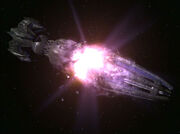
The Year of Hell is prevented from occurring once again
The impact, and the resultant destabilization of the temporal core, caused a temporal incursion within the weapon ship, erasing itself and all of its previous changes. As a result, Voyager was warned away from Krenim space on Day 1 by the same ship they originally encountered (with much less belligerency), and were able to plot a course around the Imperium. ( VOY : " Year of Hell ", " Year of Hell, Part II ")
At the end of " Before and After ", Janeway asks Kes to provide any information she has on the Krenim, which she had experienced in her time jumps, and she agrees to file a report. Even though the dialogue from "Year of Hell" does not directly reflect on any of the knowledge Kes shared, Tuvok picked up on the Krenim torpedo being in temporal flux as soon as the first torpedo hit, thus suggesting that Kes' report was indeed put to good use, even though it was not actually acknowledged. However, the lack of any reaction on the part of the bridge crew to the species name "Krenim", during first contact with them, could suggest otherwise, unless the time ship's alterations somehow affected Kes' experiences traveling backwards through time, causing her to have never written a report. However this would have been undone along with all other changes when the time ship was erased from history, causing her to have written the report in the prime timeline.
Apocrypha [ ]
In the Voyager relaunch novel A Pocket Full of Lies , the crew learn about the Year of Hell in the true timeline when they encounter an alternate version of Janeway created during the events of " Shattered " as the result of a Krenim attack; the Krenim manipulated Janeway into believing that she had been abducted by the Zahl and rescued by the Rilnar to keep her confined. In the course of their investigation, the crew deduce that, in the 'original' timeline, Voyager used Seven of Nine's expertise to plant various transphasic log buoys throughout Krenim space that were protected from the changes in the timeline, each encoded to only respond to Janeway's access codes if recovered in this specific quantum reality. The Krenim somehow recovered some of these probes and learnt about Janeway's role in Annorax's defeat, while the USS Vesta manages to recover one of the last probes while investigating the existence of the alternate Janeway. These probes include various log records of events such as Janeway ordering the rest of the crew to leave and The Doctor attempting to order Janeway to stand down due to being unfit to command, but naturally do not include the final outcome of this timeline, although the fact that they exist in this manner allows Janeway to confirm that she defeated the temporal weapon ship in some way.
- 2 Bell Riots
- 3 Daniels (Crewman)

IMAGES
COMMENTS
Temporal shielding was a type of deflector shield technology developed by the crew of the USS Voyager in an alternate timeline in 2374 in order to defend themselves against Krenim chroniton torpedoes, which had the ability to penetrate conventional shields due to being in a constant state of temporal flux. In this timeline, Voyager came under near-constant attack upon entering a region of ...
The term 'shields' first appears in the Star Trek episode "Balance of Terror", in which they were deployed, albeit to little effect, by a Federation outpost under attack from a Romulan Warbird.The first depicted use by a starship was in the Star Trek episode "Arena", in which the USS Enterprise raises its 'screens' after being attacked by an alien warship although the term 'shields' is not ...
Deflector shields worked by forming a layer or layers of energetic distortion with a high concentration of gravitons around the object to be protected. The shield on starships was divided into six sections: forward, starboard, port, aft, dorsal, and ventral. ( Star Trek Nemesis) Shield energies could be emitted by a localized antenna or "dish ...
Ablative generators were an advanced armor technology used by Starfleet. Shield emitters generated a nearly-impenetrable layer of armor around the hull of a ship so equipped. This defensive technology was acquired by the crew of USS Voyager in 2378 from Admiral Kathryn Janeway of an alternate timeline. (VOY: "Endgame") In the alternate timeline, ablative generators were developed as an anti ...
About Press Copyright Contact us Creators Advertise Developers Terms Privacy Policy & Safety How YouTube works Test new features NFL Sunday Ticket Press Copyright ...
Even with shields at maximum (during a climactic battle, at least), Star Trek ships feel the brunt of phaser blasts and photon torpedoes. Adding the deflector dish allows some of that damage to be reflected into space. Still, even as the shields fall (dramatically) to 50 percent, 20 percent, and so on, they still protect the ship better than ...
Fleet Admiral. Admiral. Mar 17, 2008. #3. To be sure, "no beaming through shields" was first established in the TOS episode "A Taste of Armageddon" - and then blatantly broken in that very same episode! In the 24th century, a couple of techniques have been demonstrated for beaming through shields. Our VOY heroes could be using these techniques ...
I'm watching the Voyager episode Persistence of Vision from season 2.. Two ships just decloaked off the bow of the ship and Commander Chakotay ordered evasive maneuvers. The Captain in me said he should've called for (at least) a Yellow Alert, shields up, before opening a channel or evasive maneuvers.
USS Voyager (NCC-74656) is the fictional Intrepid-class starship which is the primary setting of the science fiction television series Star Trek: Voyager.It is commanded by Captain Kathryn Janeway. Voyager was designed by Star Trek: Voyager production designer Richard D. James and illustrator Rick Sternbach.Most of the ship's on-screen appearances are computer-generated imagery (CGI), although ...
LCARS =^= Voyager Animation. LCARS VOYAGER ANIMATION. The Library Computer Access and Retrieval System (LCARS) Flash animations now video used in these pages is a resource from the original layouts used in the Star Trek: The Next Generation, Deep Space Nine, Voyager. The Motion Pictures - Star Trek: Generations, First Contact, Insurrection and ...
In the Star Trek: Voyager episode "Resolutions", how did they transport the cure for the disease from the Vidiians through the Vidiian shields which were up? If Voyager can't get it to transport t...
Kurtwood Smith guest stars as the troubled Annorax "Year of Hell" is a two-part episode from the fourth season of the American science fiction television series Star Trek: Voyager which aired on UPN in November 1997. It aired in two parts, on November 5 and November 11, 1997. Part I was directed by Allan Kroeker and Part II by Mike Vejar; it was written by Brannon Braga and Joe Menosky.
In an internal production document they entitled the Star Trek: Voyager Technical Guide Version 1.0 (p. 22), Rick Sternbach and Michael Okuda emphasized that the vessel's "DEFENSIVE SHIELDS" were "distinctly different from the NAVIGATIONAL DEFLECTOR." External link [] Navigational deflector at Memory Beta, the wiki for licensed Star Trek works
Every torpedo we saw fired at a Borg ship prior to Voyager developing transphasic torpedoes also appeared to bypass the shields and directly hit the hull of the ship. Perhaps they hadn't adapted yet as of Q Who, and perhaps shields were already down at Wolf 359 and Sector 001, but the only time I recall Borg ship shields actually have any ...
They are, essentially, alternate universes to and incompatible with the "main" Trek universe as seen in TOS, TNG, DS9, and Voyager. The recent series such as Discovery and Strange New Worlds make that incompatibility especially clear. But, to the point: shields at warp were commonplace prior to Star Trek (2009). (You cite some of the ...
The programming for the shields is probably buggy and experimental, the hardware unreliable. Or, it works in a completely different way RE Year of Hell Voyager took much more beating than any Starfleet ship we ever seen. Voyager shields seem designed to let as much "leak through" as possible but work overall for much longer.
Abstract. Deflector shields in Star Trek are mainly directed toward absorbing fire from hostile ships or deflecting large objects from the path of the ship. However, there are also navigational deflector shields that protect the ship from small objects that might be encountered while the ship is under power. This is more similar to the shields ...
Covariant shielding was an extremely powerful form of starship deflector shielding technology, difficult to penetrate with conventional weaponry. The starship utilized by the interstellar fight promoter Penk to transmit Tsunkatse matches to various locations was protected by tetryon-based covariant shielding, along with reinforced hull plating and neutronic weaponry. In 2376, while attempting ...
A shield frequency, shield harmonic, or shield modulation refers to the frequency settings of the shield emitters on a particular starship. If an enemy force were to obtain this frequency, they can modify their weapons to bypass the shields entirely. (Star Trek Generations) Shield functionality can be regained by remodulating the shields.
Display showing Voyager's shield frequency remodulating. A shield frequency, shield harmonic, or shield modulation referred to the frequency settings of the shield emitters on a particular starship.If an enemy force obtained this frequency, they could modify their weapons to bypass the shields entirely. (Star Trek Generations) Shield functionality could be regained by remodulating the shields.
Transporter chamber and control console aboard the USS Voyager, as seen on Star Trek: Voyager. Creator Gene Roddenberry's original plan did not include transporters, instead calling for characters to land the starship itself. However, this would have required unfeasible and unaffordable (for the 1960s) sets and model filming, as well as episode running time spent while landing, taking off, etc.
Episode Preview: Resolutions. Season 2, Episode 25. When Captain Janeway and Chakotay contract an incurable virus they are left on a planet which shields them from its effects. While Janeway searches for a cure, she begins to form a deeper relationship with her first officer. Stay tuned to StarTrek.com for more details! And be sure to follow ...
The damaged ready room aboard Voyager. On 17 April (Day 32), a Krenim attack resulted in the overload of EPS conduits across the starboard side of Deck 5, sections 10-53, killing two crew members. Voyager happened to take down the aft shields of the Krenim warship during the battle and destroyed it by releasing photon torpedoes like mines, but apparently another ship took its place.